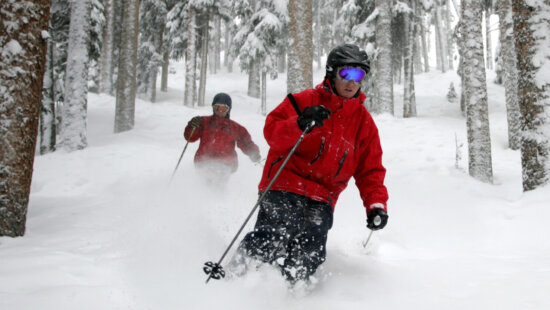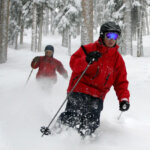Environment
Douglas-fir beetles headed uphill and west in Summit Park

PARK CITY, Utah — A recent outbreak of Douglas-fir beetles in Summit Park has prompted swift action from forestry experts and local partners, who are working to protect surrounding trees and prevent the infestation from spreading.
The outbreak, likely triggered by downed timber left on a building site, has affected a stand of century-old Douglas firs. Officials say healthy trees have been treated with MCH, a pheromone that deters beetles from settling. Homeowners are urged to monitor their properties and continue annual treatments until the threat subsides.
Community partners hosted forestry experts for a field-based learning session focused on the recent Douglas-fir beetle outbreak in Summit Park. As PJ Abraham, Northern Area Forester, explained, Douglas-fir beetles are native to Utah and generally do not cause problems unless there is a triggering event such a big storm that knocks down or damages large numbers of trees.
Effected area treated with anti-aggregation pheromone MCH
Healthy trees around the infested area have been treated with the anti-aggregation MCH pheromone (3-methylcyclohex-2-en-1-one). MCH informs newly arriving beetles that the tree is already occupied, preventing overcrowding. Male Douglas-fir beetles excrete this pheromone in order to improve brood survival. Treatment with MCH has been shown to prevent healthy trees from being attacked. Treatment is needed annually until the infestation subsides.
Douglas-fir beetles need old growth Douglas firs to survive
Colleen Keyes, Forest Health Coordinator with the Utah Division of Forestry, Fire and State Lands, explained that Douglas-fir beetles fly between mid-June and the end of August at an elevation of 7000 feet. While they can kill trees less than 10 to 12 inches in diameter, they cannot support a brood unless the trees are larger. The area affected in Summit Park consists of a very dense stand of mostly Douglas firs with many over 150 years old.
The infestation is being monitored. Currently the beetles are flying uphill and towards the west. Douglas-fir beetles can fly several miles with the help of wind in open areas, but they tend to fly to the closest suitable tree. They have a one-year life cycle.
Monitor your property for damaged large Douglas firs
The cause of this outbreak is likely the cutting of mature trees in preparation for building a home. The beetles can live in trees that have been dead for up to two years. Unfortunately, these trees were not removed from the property. No home has been built so the beetles had several years to increase in population.
Residents should continue checking their Douglas firs for bore holes, beetles and egg galleries. Female Douglas-fir beetles create vertical tunnels with eggs deposited on both sides. MCH is still available through the Summit Park HOA to homeowners close to the infested site.



















